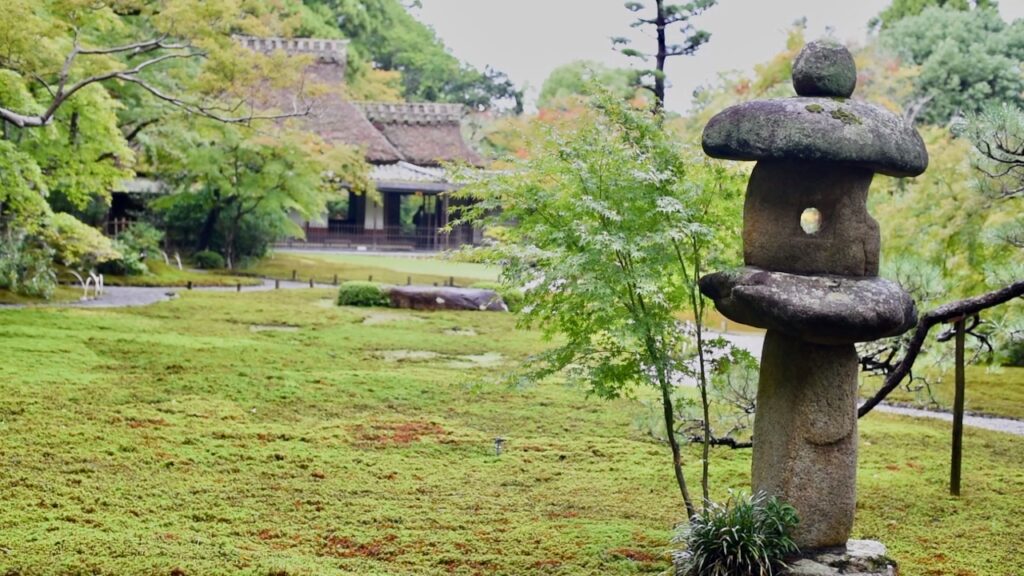
門をくぐると、空気の粒がひとつ柔らかくなるのを感じました。奈良の町なかにいるはずなのに、不思議と境界線を跨いだような感覚になります。池の水面が陽を受けて揺らぎ、その手前の石と緑が輪郭をやさしく縁どっている。まず最初に迎えてくれるのは「静けさ」ではなく「生きた気配」です。視線を上げると、池の奥に小さな東屋が見えます。そこへ続く築山のラインが、段丘のように丁寧に積み重ねられ、まるで視線そのものを導かれているようでした。「歩く」というより「登っていく」庭。古い図面の立体化を眺めているような高低差の表情が、この庭の入口での第一印象です。よく見ると、築山の中腹には庭師さんが黙々と手入れをしていました。
庭は「完成品ではなく、生き物」だという当たり前のことを、この光景が静かに教えてくれます。人の手が入るからこそ景色になる。そんな呼吸がここにはありました。When I stepped through the gate, the air itself softened, as if each particle of it had relaxed.
Although I was still in the heart of Nara, it felt as though I had quietly crossed a boundary into another realm.
The surface of the pond shimmered in the sunlight, and the stones and greenery along its edge framed the scene with a gentle clarity.
What greeted me first was not silence, but the sense of something alive.
When I lifted my gaze, I noticed a small pavilion across the water.
The line of the gently rising mound seemed layered like a terraced hillside, guiding not just the path of my feet, but the direction of my eyes.
This is not a garden you merely “walk” — it is one you ascend.
The undulating height of the land feels like an old garden drawing made three-dimensional.
Looking more closely, I saw a gardener working quietly halfway up the slope.
It was a reminder that a garden is not a finished object, but a living being.
It becomes a landscape because human hands continue to tend it — that is the rhythm of breath at the heart of this place.

池の庭を離れると、景色は一気に“面の静けさ”へと変わります。
苔が地表をすっかり覆い、色も音も柔らかく吸い込んでしまうような空気。ここでは庭の奥行きではなく、“呼吸の深さ” が中心になります。
足元の飛石は歩幅を細め、自然と歩く速度が落ちていきます。
目線は低くなり、心は内側へ降りていく。まるで庭がこちらの姿勢を整えているかのようです。
奥には茶室が静かに佇み、苔庭はその“手前の間(ま)”として機能しています。
いきなり茶の空間に入らず、まず苔の静けさの中で余分なものをそぎ落としていく。この“導線の思想”が、日本庭園らしい精神の礼法として現れています。
Leaving the pond garden, the scenery shifts into a quiet, unbroken surface of green.
The moss absorbs sound as well as color, creating a space where depth is not measured by distance, but by breath.
The stepping stones gently shorten the stride, slowing the body before the mind even notices.
Your gaze drops, your pace softens, and little by little the heart turns inward. It feels as if the garden itself is adjusting your posture.
At the back stands the tea house, waiting without insistence.
The moss garden serves as a threshold — a gentle pause before one enters the realm of tea.
It does not rush you in; instead, it removes what is excess, so that you may arrive with a quieter self.

苔の庭を抜けると、景色はさらに柔らかくなり、音の輪郭までも淡くなります。
杉苔の上にそっと置かれた石の道は、まっすぐではなく、あくまで“たどり着く”ための道。急がず、誇張せず、ゆっくりと心を運ばせてくれます。
奥に見える茶室は「迎える建築」ではありません。
そこに“鎮座しているだけ”なのに、存在そのものが「ここに心を据えよ」と語りかけてくる。
華美さではなく、「姿勢の整え方」で魅せる佇まいです。
枝は屋根を覆うように差しかかり、苔は地を柔らかく受け止め、石はその間をそっと結ぶ。
ここでは庭と建物が切り離せない。どちらも“茶の前の静寂”をつくるための一体の器です。
Beyond the moss garden, the scenery softens even further, and even the outline of sound grows faint.
The stepping stones laid across the green are not a straight path but a gentle approach — a way of arriving, rather than merely reaching a destination.
The tea house in the distance does not “invite” you; it simply rests there, and by its stillness tells you that your heart, too, may come to rest.
Its beauty lies not in decoration, but in posture.
Branches shelter the roof, the moss receives the earth’s breath, and the stones weave the two together.
Here, the garden and the architecture are not separate things — they are one quiet vessel, preparing you for the world of tea.

茶室を前にしばらく佇んでいると、景色の見え方が少し変わってきました。
さきほどまで「庭を眺めていた」はずなのに、今は景色のほうがこちらを静かに見返してくるような感覚があります。
苔の面は余白となり、灯籠はただそこに立つことで庭の“核”を示している。
飾らず、語らず、主張もしない。ただ居ることそのものが、美しさになる世界です。
吉城園という庭は、歩き進む場所ではなく、「立ち止まる場所」へと導いてくれました。
外の音も、心のざわめきもここでは遠く、景色の中に自分がゆっくり溶けていく――
そんな余韻を抱いたまま、私はこの庭を後にしました。
Standing before the tea house for a while, I noticed the scenery shifting.
A moment earlier I believed I was looking at the garden — now it felt as though the garden was quietly looking back at me.
The carpet of moss became a field of silence, and the stone lantern no longer “decorated” the space but revealed its center simply by existing.
No display, no assertion — only presence, and that presence was enough.
Yoshikien is not a garden that asks you to move forward, but a garden that gently allows you to come to rest.
The outer world grows distant, and little by little you dissolve into the stillness itself —
carrying that quiet with you as you leave.
この苔庭や茶室の佇まいを、写真ではなく“映像の息づかい”で味わってみたい方は、下に添えたYouTube動画でゆっくりとご覧ください。
庭の空気の揺らぎや、音のない時間の深さが、きっと伝わると思います。
Yoshikien is not a garden you walk through, but a garden you arrive at.
After touching the quiet breath that lives beneath its stillness, even time itself begins to feel like a gift.
For those who would like to experience this space not only in photographs but in its living atmosphere, I have included a short YouTube video below.
Through moving images, you can feel the texture of the silence — the way the garden breathes.


コメント